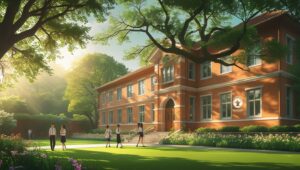 In the scorching cities of Niamey and Maradi, Niger’s two largest urban centers, schoolyards are becoming unexpected green sanctuaries. A recent study of 60 schools has revealed that trees in school compounds are not only cooling overheated classrooms but also serving as tools for education, sources of nutrition, and symbols of resilience in the face of climate change.
In the scorching cities of Niamey and Maradi, Niger’s two largest urban centers, schoolyards are becoming unexpected green sanctuaries. A recent study of 60 schools has revealed that trees in school compounds are not only cooling overheated classrooms but also serving as tools for education, sources of nutrition, and symbols of resilience in the face of climate change.
With rising temperatures and frequent heatwaves across the Sahel region, where temperatures often exceed 45°C, the importance of urban forestry is gaining new recognition. Trees in schoolyards play a critical role in reducing heat stress, creating shaded outdoor learning environments, and improving air quality. In overcrowded or under-resourced schools, these shaded spaces often double as open-air classrooms, offering a cooler, more comfortable place for students to learn.
The research, led by a team from the University Dan Dicko Dankoulodo in Maradi, documented 62 woody species from 31 plant families across the surveyed schools. Nearly 40% of these were fruit-bearing trees, such as mango, guava, and moringa, which not only provide shade but also supplement student meals and, in some cases, generate income. The neem tree, an introduced species native to India, dominated the landscape, accounting for nearly two-thirds of all trees recorded. Valued for its drought resistance and rapid growth, neem is widely used in urban forestry efforts across arid regions.
In addition to cataloguing biodiversity and carbon sequestration potential, the researchers assessed student awareness of trees and local ecology. They found limited understanding among students, suggesting that the educational potential of these green spaces remains largely untapped. Many schools had not yet incorporated environmental activities such as tree planting or nature education into their daily routines.
However, some institutions are taking the lead. Schools like Decroly in Niamey are embedding tree-related topics into their curriculum. Here, students learn about composting, soil health, and tree care, gaining hands-on ecological knowledge alongside their traditional studies. These activities not only engage students more deeply but also connect classroom learning to real-world environmental stewardship.
The benefits of trees in schoolyards go beyond education. In-season fruits provide much-needed nutrition, and parts of trees like moringa can be used in school meals or for construction materials. Shaded areas serve as vital rest zones for students during breaks, helping to regulate their body temperatures and reduce fatigue.
With urban expansion threatening green spaces across Niger, schoolyards have emerged as protected microenvironments where vegetation can thrive. These spaces are maintained and watered by the school community, making them ideal for expanding urban forestry without competing with city development projects.
